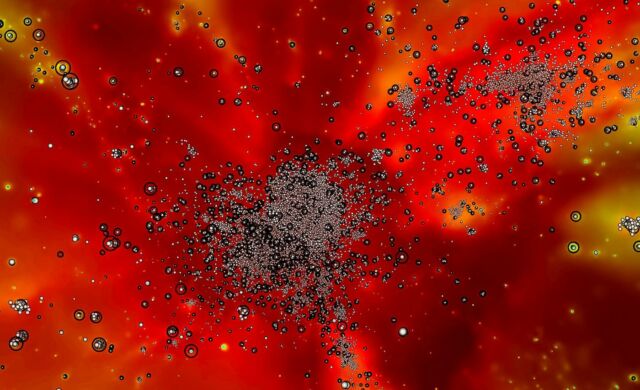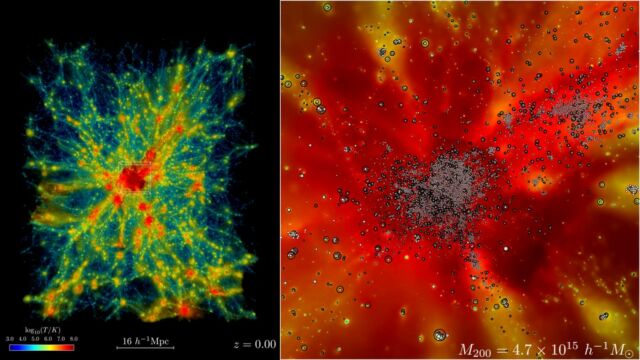 Largest-ever Astrophysical Simulation of the Universe. Argonne National Laboratory, U.S Dept of Energy
Largest-ever Astrophysical Simulation of the Universe. Argonne National Laboratory, U.S Dept of Energy
Scientists at the Department of Energy’s Argonne National Laboratory used Frontier, the world’s fastest supercomputer, to carry out the largest-ever astrophysical simulation of the universe.
The simulation used HACC (Hardware/Hybrid Accelerated Cosmology Code), a supercomputing framework created 15 years ago for petascale systems.
This animation highlights the formation of the largest structure in the Frontier-E simulation. The left panel shows a small section of the simulation, about 64x64x76 Mpc/h in size (just 0.00001 of the total simulation volume), while the right panel zooms in for a detailed view. Both panels display gas density, with colors representing temperature. On the right, white circles indicate star particles and black circles mark AGN (active galactic nuclei) particles.
In 2012 and 2013, HACC was a finalist for the prestigious Gordon Bell Prize in computing.
Later, HACC was enhanced under ExaSky, a project led by Salman Habib as part of the Exascale Computing Project (ECP). This $1.8 billion DOE initiative (2016–2024) united thousands of experts to develop cutting-edge applications and tools for exascale supercomputers, capable of performing over a quintillion calculations per second.

A small sample from the Frontier simulations reveals the evolution of the expanding universe in a region containing a massive cluster of galaxies from billions of years ago to the present day (left). Red areas show hotter gasses, with temperatures reaching 100 million Kelvin or more. Zooming in (right), star tracer particles track the formation of galaxies and their movement over time. Credit: Argonne National Laboratory, U.S Dept of Energy
“There are two components in the universe: dark matter — which as far as we know, only interacts gravitationally — and conventional matter, or atomic matter.” said project lead Salman Habib, division director for Computational Sciences at Argonne.
“So, if we want to know what the universe is up to, we need to simulate both of these things: gravity as well as all the other physics including hot gas, and the formation of stars, black holes and galaxies,” he said. “The astrophysical ‘kitchen sink’ so to speak. These simulations are what we call cosmological hydrodynamics simulations.”
source Oak Ridge National Laboratory





Leave A Comment